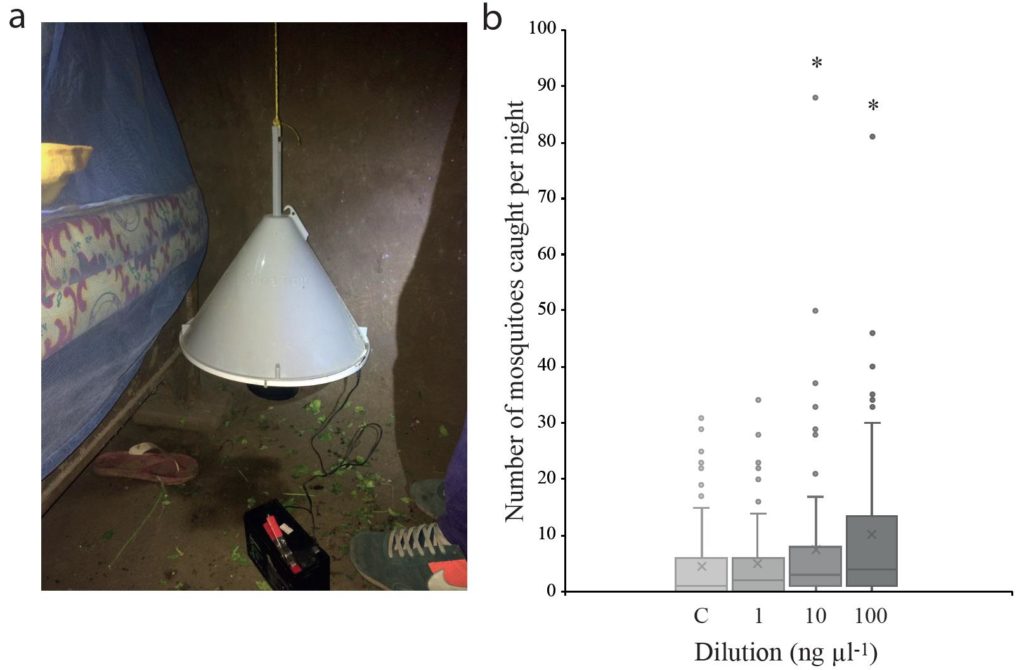
Parasites and their insect vectors coevolve, and this long-term association maintains the transmission of the parasites from infected to non-infected vertebrate hosts. Researchers in 2005 demonstrated that patients with malaria were more attractive to mosquitoes that vector the parasites than healthy people. In addition, patients with the transmissible stage of the parasite (gametocytes) in the blood vessels just under the skin, were even more attractive to the mosquitoes. Did this mean that the parasites were signaling to the mosquitoes for a ride?
A possible explanation for how the parasites could do this was shown three years ago by a research team in Sweden. This team showed that the transmissible parasites are acting to change how infected people smell and taste. By releasing a metabolite ((E)-4-hydroxy-3-methyl-but-2-enyl pyrophosphate, otherwise known as HMBPP), the gametocytes indirectly increase the release of odours (aldehydes, monoterpenes and carbon dioxide) that the mosquitoes find irresistible, and then HMBPP directly changes the taste of the blood to be extra tasty. If a mosquito is more drawn to an infected person, and takes a full blood meal, that mosquito is more likely to pick up the parasite, and then becomes capable of passing it on to another person. As a result, this manipulation of the vertebrate host’s taste and smell is a powerful weapon in the parasite’s arsenal to increase malaria transmission.
We recently asked ourselves “How can we use the parasites’ own weapons against them?” We started by testing the efficiency of these odours for attracting malaria vectors under field conditions in Ethiopia – and we are quite sure that we can! The first successful evidence was that we were able to capture more mosquitoes in an odour-baited trap as we increased the release rate of the HMBPP-induced odour. In this experiment, the odour was released next to a sleeping volunteer who was protected by a bed net, to mimic the change in odour that an infected person would exhibit.

Although this initial experiment indicated that mosquitoes were more attracted to people perfumed with the HMBPP-induced odour, than those without it, this was conducted with different people, in different houses. We also wanted to see if the HMBPP-induced odour added to one person’s odour could attract more mosquitoes than that same person’s body odour alone. To do so, we asked each volunteer to sleep in a tent. Then, by diverting the body odour of each volunteer into two pipes with fans, we were able to pass their odour, either supplemented with HMBPP-induced odour or not, over one of two traps 10 meters away from the tent. The trap that was augmented with the HMBPP-induced odour attracted two times more malaria mosquitoes than the trap with only the human odour.
Interestingly, the level of attraction shown by the mosquitoes for the human odour augmented with the HBMPP-induced odour was similar to that of people infected with malaria. If we omitted the human odour from the tent, we more-or-less caught no mosquitoes at all, meaning that the HMBPP-induced odour requires the presence of the entire odour of a person to be effective.

So how can we use this new knowledge to help to protect us from getting malaria? We already have many measures that are working to reduce malaria, in an integrative vector management system. Here, we are providing another, odour-based, tool that can be added to the programme. The next step will be to formulate the different components that make up the odour so that it is both inexpensive and effective over a long time period. It could be as simple as hanging a trap with an odour sachet at the foot of your bed, or incorporate the odour into other existing strategies, such as the eave tube technology.
Adding the odour to the eave tubes would increase the efficiency of the technology with the added advantage that the mosquitoes would not be able to enter the house. In the near future, we believe that we can all look forward to more odour-based technologies being created and implemented for the control and monitoring of all sorts of disease vectors.

Comments